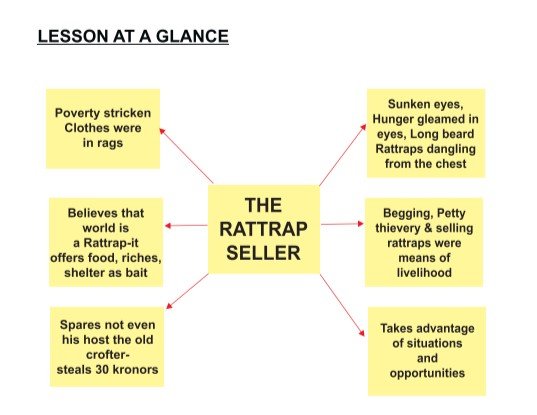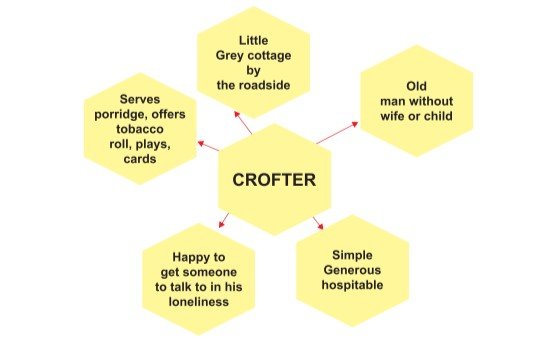Summary of The Rattrap
‘The Rattrap’ is the 4th chapter of the CBSE English textbook for Class 12 – Flamingo. The story is written by Selma Lagerlöf. It talks about how humanity has innate goodness in it and how a proper treatment of people’s problems with kindness and understanding can really bring out the hidden or lost faith in humanity again. The main character is a vendor who sells rattraps and considers the whole world to be an evil trap where human beings are waiting to be caught like rats. Read on to get ‘The Rattrap’ Class 12 summary, and for further content on English related to Class 12th you can refer to CBSE Notes on the official BYJU’S website. Our website also has a section on CBSE Summary where you can find short and concise summaries meant for quick revisions and reference to chapters in the CBSE English textbooks.
Conclusion of The Rattrap
This story captures the essence of faith in humanity. The daughter knew that the rattrap seller was not the person her father had assumed to be and his intentions were wrong. Still, she believed that her care and sincerity towards that person might make him believe in the goodness of humanity again. The seller always considered the world an evil place and compared it to a rat trap. After reading The Rattrap Class 12 summary we understand that the rattrap seller in the story, indeed, had some goodness and compassion for people around him. He was finally able to realise the consequences of his wrong deeds and thoughts, and resolved to do the right thing.
This particular chapter from the Class 12 syllabus for CBSE English entails a valuable lesson. Understanding this chapter is crucial for scoring good marks in the literature section of your board examination. BYJU’S offers multiple sources of learning materials on English that will help you tackle any kind of problem confidently.
Theme of the Lesson
The potential of kindness and human connection to change even the most hardened and distrustful people is the central topic in Selma Lagerlof’s “The Rattrap.” The narrative chronicles the travels of an elderly vagrant who receives a little rattrap from a generous and caring hostel owner. The tramp encounters several individuals along the way who, in spite of their own challenging situations, are kind and generous to him. The tramp reflects on his own life and actions as a result of this encounter, which finally inspires him to make amends and improve himself. The underlying message is that everyone is capable of change and that even the smallest act of kindness can have a big impact on someone else’s life.

MAIN POINTS OF THIS CHAPTER




Read the passages below and answer the questions that follow:
RTC 1
- The world had, of course, never been very kind to him, so it gave him unwanted joy to think ill of it in this way. It became a cherished pastime of his, during many dreary ploddings to think of people he knew who had let themselves to be caught in the dangerous snare, and of others who were still circling around the bait.
- He felt that the world was unkind to him because
(i) people did not talk to him
(ii) he had to resort to begging and thievery for food
(iii)he had to make rattraps
(iv)things had gone downhill with him
2.His persistent pastime thought was
(i) to steal food
(ii)to make new rattraps
(iii)that this world is a huge rattrap
(iv)that the world is full of land and seas - Here he thinks the ‘dangerous snare’ is
(i)selling small rattraps of wire
(ii)plodding along the roads alone.
(iii)begging and stealing
(iv)getting tempted to the riches. - He got the material to make rattraps from
(i)stores and farmhouses
(iii)forests and farmhouses
(ii)roadside streets and
(iv)houses and farmhouses
Answer: 1(iv), 2 (iii), 3 (iv), 4(i) - RTC 2 QUESTIONS
- “You do preach worse than a parson,” said the iron master. “I only hope you won’t have to regret this. “The young girl took the stranger by the hand and led him up to the table”.
- Who is “you” in the above lines?
- Why did the iron master tell the speaker that he/she was a bad speaker?
- Why did the ironmaster say this?
- Give a synonym of ‘priest”.
- SHORT ANSWER QUESTIONS
- 1.How did the peddler earn his livelihood? What kind of life did he live?
- Ans. The peddler earned his livelihood by selling small rattraps of wire, which he used to make himself from the material got by begging in the stores or at big farms. But this was not so profitable, so he had to beg or even steal. He roamed about like a vagabond all alone. He lived a sad and monotonous life with no one to welcome him.
- How did the crofter treat the peddler and why?
Ans. The crofter was a lonely man without wife or child. He craved and desired human company to share his loneliness. He welcomed the peddler and offered him porridge for supper and even tobacco. He played cards with him. He even showed him his earnings and let him know where it was kept. - What made the peddler accept Edla Willmanson’s invitation?
Ans. Edla started sympathising with the vagabond, understanding that he was going through a hard time. She was compassionate and benevolent. Her manner was friendly which made the vagabond feel confident She insisted that he could leave at his will after spending Christmas with them. Because of her friendly request, the peddler accepted her invitation.
SHORT ANSWER QUESTIONS FOR PRACTICE
- What strange idea about the world struck the peddler?
- Why did the peddler decline the iron master’s invitation?
- Pick out two instances from the story ‘The Rattrap’ to show that the peddler realized that he himself was trapped.
4.What had the peddler left behind as a Christmas gift for Edla Willmanson? Why? - Why did the peddler sign himself as ‘Captain Von Stahl”?
LONG ANSWER QUESTIONS
- The story “The Rattrap” shows that basic human goodness can be brought out by understanding and love. Elucidate.
Answer: The story ‘The Rattrap’ highlights the fact that compassion
and concern can awaken the essential goodness in a man. The peddler, who had been resorting to begging and thievery all the time, never bothered to clear his identity and be fooled the ironmaster too. But, Edla gave him a royal treatment, served him delicious supper, gifted her father’s dress to him. This kind of unconditional love and compassion from Edla made him realise his mistake and he confessed his guilt too. This way, she made a lot of difference in his life, and he got transformed into a much better person. He left the stolen money behind, along with a letter and a gift for Edla.
LONG ANSWER QUESTIONS FOR PRACTICE - The peddler betrayed the trust of the crofter and was caught in the trap of the world. Temptation to bait should be restricted at all costs. Write a note on “Strength of Character”.
2.How are the attitudes of the iron master and his daughter different? Support your answer from the text. - The story ‘The Rattrap has many instances of unexpected reactions from the characters to others behaviour. Pick out a few.

I don’t think the title of your article matches the content lol. Just kidding, mainly because I had some doubts after reading the article.
Your point of view caught my eye and was very interesting. Thanks. I have a question for you.